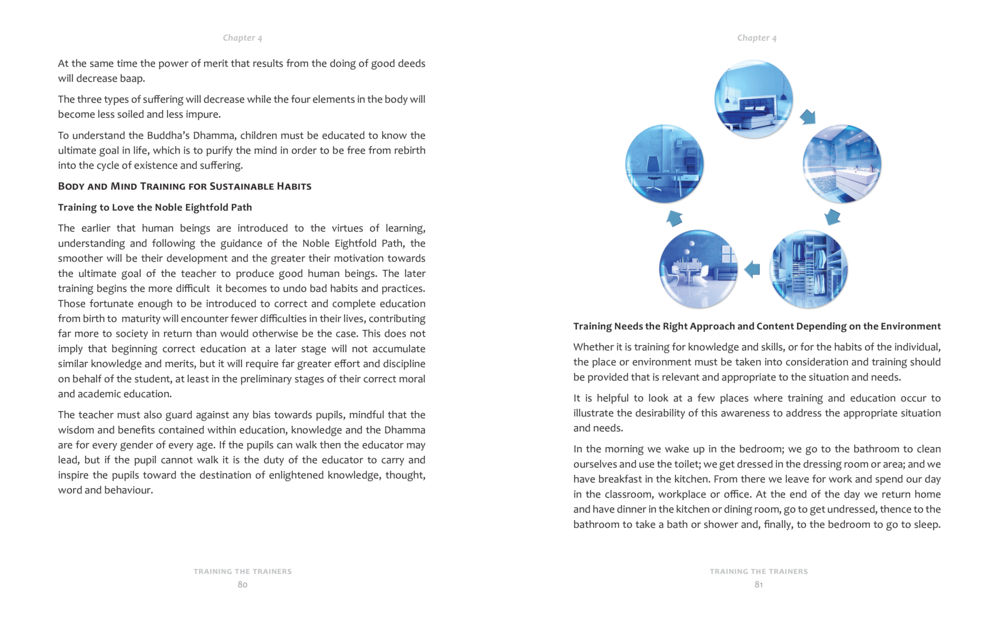Understanding Buddha's Dhamma and Sustainable Habits : หน้า 41/47
Training the trainer part 1 : หน้า 41/47 Explore the importance of early education in following the Noble Eightfold Path and its impact on reducing suffering and fostering good habits.
2 ครั้ง

สรุปเนื้อหา
บทความนี้กล่าวถึงพลังแห่งบุญและการลดทุกข์ที่เกิดจากการทำดี โดยเน้นถึงความสำคัญของการศึกษาในวัยเด็กเพื่อทำความเข้าใจธรรมะของพระพุทธเจ้า และวิธีการที่การโค้ชและการฝึกอบรมอย่างครบถ้วนสามารถช่วยในการพัฒนานิสัยที่ยั่งยืนได้ การฝึกให้รู้จักทางแปดอันสูงส่งตั้งแต่ยังเล็กจะนำไปสู่การพัฒนาที่ราบรื่นและมุ่งสู่เป้าหมายสูงสุดในการมีจิตใจที่บริสุทธิ์ เพื่อหลุดพ้นจากวงจรการเกิดใหม่และทุกข์ สิ่งนี้รวมถึงความรับผิดชอบของครูในการสอนทุกเพศทุกวัยโดยไม่มีการเลือกปฏิบัติ และการปรับเนื้อหาให้เหมาะสมกับสภาพแวดล้อมและความต้องการของผู้เรียนในกระบวนการฝึกอบรม
หัวข้อประเด็น
-ความสำคัญของบุญ
-การลดทุกข์
-การศึกษาเพื่อการพัฒนาจิตใจ
-ทางแปดอันสูงส่ง
-การอบรมโดยไม่เลือกปฏิบัติ
-ความสำคัญของสภาพแวดล้อมในฝึกอบรม
ข้อความต้นฉบับในหน้า
At the same time the power of merit that results from the doing of good deeds will decrease baap.
The three types of suffering will decrease while the four elements in the body will become less soiled and less impure.
To understand the Buddha’s Dhamma, children must be educated to know the ultimate goal in life, which is to purify the mind in order to be free from rebirth into the cycle of existence and suffering.
BODY AND MIND TRAINING FOR SUSTAINABLE HABITS
Training to Love the Noble Eightfold Path
The earlier that human beings are introduced to the virtues of learning, understanding and following the guidance of the Noble Eightfold Path, the smoother will be their development and the greater their motivation towards the ultimate goal of the teacher to produce good human beings. The later training begins the more difficult it becomes to undo bad habits and practices. Those fortunate enough to be introduced to correct and complete education from birth to maturity will encounter fewer difficulties in their lives, contributing far more to society in return than would otherwise be the case. This does not imply that beginning correct education at a later stage will not go unnoticed, there tends to be a similar knowledge and merits, but it will require far greater effort and discipline on behalf of the student, at least in the preliminary stages of their correct moral and academic education.
The teacher must also guard against any bias towards pupils, mindful that the wisdom and benefits contained within education, knowledge and the Dhamma are for every gender or every age. If the pupils can walk then the educator may lead, but if the pupil cannot walk it is the duty of the educator to carry and inspire the pupils toward the destination of enlightened knowledge, thought, word and behaviour.
TRAINING THE TRAINERS
80
Training Needs the Right Approach and Content Depending on the Environment
Whether it is training for knowledge and skills, or for the habits of the individual, the place or environment must be taken into consideration and training should be provided that is relevant and appropriate to the situation and needs.
It is helpful to look at a few places where training and education occur to illustrate the desirability of this awareness to address the appropriate situation and needs.
In the morning we wake up in the bedroom; we go to the bathroom to clean ourselves and use the toilet; we get dressed in the dressing room or area; and we have breakfast in the kitchen. From there we leave for work and spend our day in the classroom, workplace or office. At the end of the day we return home and have dinner in the kitchen or dining room, go to get undressed, then once to the bathroom to take a bath or shower and, finally, to the bedroom to go to sleep.
หน้าหนังสือทั้งหมด
หนังสือที่เกี่ยวข้อง
Load More















































